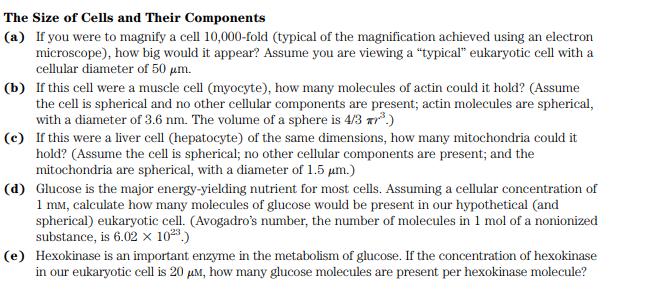Answered step by step
Verified Expert Solution
Question
1 Approved Answer
The Size of Cells and Their Components (a) If you were to magnify a cell 10,000-fold (typical of the magnification achieved using an electron

The Size of Cells and Their Components (a) If you were to magnify a cell 10,000-fold (typical of the magnification achieved using an electron microscope), how big would it appear? Assume you are viewing a "typical" eukaryotic cell with a cellular diameter of 50 m. (b) If this cell were a muscle cell (myocyte), how many molecules of actin could it hold? (Assume the cell is spherical and no other cellular components are present; actin molecules are spherical, with a diameter of 3.6 nm. The volume of a sphere is 4/3 .) (c) If this were a liver cell (hepatocyte) of the same dimensions, how many mitochondria could it hold? (Assume the cell is spherical; no other cellular components are present; and the mitochondria are spherical, with a diameter of 1.5 m.) (d) Glucose is the major energy-yielding nutrient for most cells. Assuming a cellular concentration of 1 mm, calculate how many molecules of glucose would be present in our hypothetical (and spherical) eukaryotic cell. (Avogadro's number, the number of molecules in 1 mol of a nonionized substance, is 6.02 10) (e) Hexokinase is an important enzyme in the metabolism of glucose. If the concentration of hexokinase in our eukaryotic cell is 20 M, how many glucose molecules are present per hexokinase molecule?
Step by Step Solution
★★★★★
3.46 Rating (169 Votes )
There are 3 Steps involved in it
Step: 1
The detailed ...
Get Instant Access to Expert-Tailored Solutions
See step-by-step solutions with expert insights and AI powered tools for academic success
Step: 2

Step: 3

Ace Your Homework with AI
Get the answers you need in no time with our AI-driven, step-by-step assistance
Get Started


